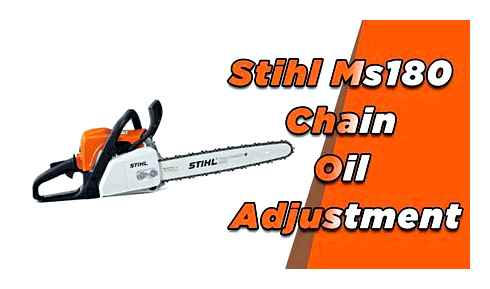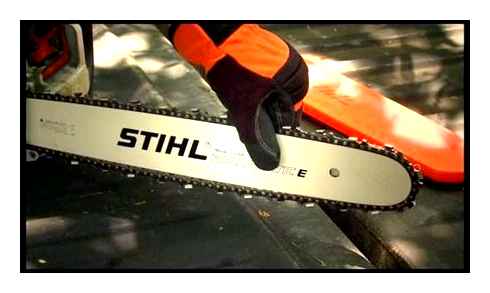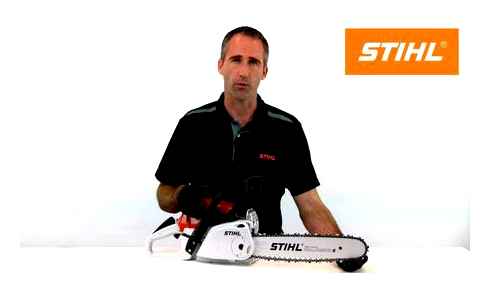How to retighten the chain on a STIHL chain saw
Why chainsaws pull quickly?
A quick check of chain tension is straightforward: Just grip the sprocket and pull it up. If the chain is tightened correctly the tail of the chain sinks into the bar groove by 1/3 of its height. Excessive tensioning indicates excessive tensioning, and a decrease in tensioning indicates weak tensioning.
The saw should normally be able to move freely along the bar, with very little effort. If the movement of the element is difficult, it is a sign of excessive tensioning.

If the chainsaw’s cutting element is under too much tension, the bar begins to heat up and wear down, increasing the load on the engine, and it will wear out quickly. Never start the machine if the chain is loose because the chain can get caught and cut off while you are sawing and this can endanger the user of the machine. The chain can come off the guide bar and injure your limbs, and it often damages itself and the guide bar. Working with a loose chain element also causes the bar to wear on one side so that the machine stops making straight cuts and the saw slides to the side.
What you need
To adjust chainsaw chain tension you will need:
- Allen wrench for chainsaw cover nuts.
- Slotted or Phillips head screwdriver for the adjusting screw.
- Tight gloves for checking chain tension.
A suitable wrench and screwdriver are usually included with the chainsaw. Gloves are needed to avoid injuring your hands on the sharp chain. You can also check the tension using two screwdrivers on opposite sides of the bar for checking rotation.
The keyless tensioning system
it is relatively new, if not revolutionary. Differs from the classic wrench, as follows:
There is a wing nut (swivel cap) with a knob for tightening by hand instead of a 13mm wrench nut on the cover. It also has a nut, but it is hidden inside. Instead of using a screwdriver adjusting screw on this system, you tighten the tension using the tension wheel (adjusting knob).
A sprocket and washer instead of a pinion shaft.
- the mechanism itself is more complicated than the traditional wrench;
- installing the cutting set causes additional problems, t.к. makes it difficult to get all the parts in the right order;
- Smaller adjustment stroke, a slightly stretched chain will still work with a traditional tensioning system, here it will sag and become unusable.
The pluses are noted only one: no need for a screwdriver and wrench, adjustment and tightening are done by hand. I can’t get any positive feedback on this system. On the contrary, there are many negatives. For those who are used to traditional adjustments, the keyless system seems like a technical puzzle when it comes to assembly.
Perhaps in time the keyless system will prove its usefulness. But so far it is getting to the point where customers return their new chain saws back to the store and replace them with conventional ones, still not being able to understand the assembly and benefits of the new system.
When to retighten the chain
No one should work with a very slack chain.
The chain that “jumps” while sawing can break the bar groove and damage the teeth in the sprocket.
A slipping chain can damage parts of the machine. But the biggest risk is injury to the operator. Despite the brake and the catch, a loose chain can whip along an unpredictable path, and this is extremely dangerous.
It is imperative that the tension be checked before starting work. There are two signs of critical looseness during operation:
If this occurs, switch off the engine and check the tensioning.
How to Check Proper Tension?
To check the quality of the tensioning, pull it gently away from the middle of the bar.
Allow no more than 2/3 of the length of the tails of the cutting links to protrude.
You can also determine the need for tightening by the following signs:
- Creaking and squealing in the area of the main drive sprocket;
- loosening of the safety mechanism, bar fasteners;
- jamming when sawing, increased vibration and noise.
The chainsaw has reduced productivity and operating time. Even when sawing soft types of wood, the chain starts to stick in the groove, speed drops and smoothness of movement decreases.
Tensioner mechanisms
Depending on the design features of the tool, the mechanism for tensioning the headset may differ.
Low-cost models of chainsaws have a classic straight-threaded bolt on the side of the body for adjusting the chain.
This option comes with a special tensioning wrench or an external slot for a slotted screwdriver.
All professional models have more convenient adjustment mechanisms. They can be used to tighten the chain in one movement of the lever or by turning a special disc. They are constructed with an integrated tensioner and are secured by a locknut when turning. On some models, adjustment is made by locking the bar in a certain position on the tool cover. Regardless of the method, the chain tension needs to be corrected only when cooled. When the chain is hot, it causes slack in the chain as it cools.
How to check tensioning?
To ventilate the quality of tensioning, you should gently pull it back in the middle part of the bar.
The permissible level of output of the tails of the cutting links should not be more than 2/3 of their length.
You can also determine the need for tightening by the following signs:
- Creaking and squealing in the area where the main drive sprocket is located;
- loosening of safety mechanism tightening, bar fastener;
- jamming when sawing, increased vibration and noise.
The chainsaw has reduced productivity and operating time. Even when sawing soft types of wood the chain starts to stick in the groove, speed is reduced and smooth operation is smooth.
Tensioning mechanisms
The tensioning mechanism on the cutting attachments may vary, depending on the design of the tool.
Low-priced chainsaws use a classic straight-threaded bolt on the side of the body to adjust the chain.
This variant is equipped with a special tightening key or has an external slot for a slotted screwdriver.
All professional models are equipped with more convenient adjustment mechanisms. With them, the chain can be tightened with one movement of the lever or by turning a special disc. Their design consists of a built-in tensioner, locking when turning is achieved by a locknut. On some models, adjustment is made by locking the bar in a certain position on the tool cover. Regardless of the method, chain tension should only be corrected when the chain is cooled. Tensioning of a hot chain causes slack in the chain as it cools.
Keyless tensioning system
Relatively new, if not cutting-edge. Differs from the classic wrench, as follows:
Instead of a 13-mm wrench nut, there is a wing nut (twist cap) on the cover with a knob for tightening by hand. It also has a nut, but it is hidden inside. Instead of the screwdriver adjustment screw on this system, the tensioning is done with the tensioning wheel (adjustment knob).
Sprocket and washer instead of pinion shaft.
- The mechanism itself is more complicated than a traditional wrench;
- Installation of cutting attachments causes additional problems, t.к. Makes it difficult to get all the parts mated in the right order;
- Smaller stroke of adjustment, slightly stretched chain still will serve at traditional system of tensioning, here it will sag, and becomes unsuitable for operation.
Clutch defective
| Failure | Possible Cause | Remedy |
| The chain keeps turning without stopping, with any adjustment of the carburetor. Motor is not running smoothly. | The spring in the drum is snapped. | Remove spring and replace with a new one, or install a new assembly. |
| The chain is turning almost constantly, making strange noises. | Chipped cam. |
Reasons why it is necessary to disassemble clutches:
- Defective or broken spring;
- As a result of loads on the chainsaw and wear of parts, the spring has left its place;
- Chipping on the clutch plate;
- Parts wear.
How to tension a sagging chain if there is nowhere else to pull?
Note that the option of removing the link I will not even consider.
For this work we will need a few tools.
- An angle grinder with metal cutting wheel. You can use a sharpening machine.
- Hex key with 5 mm diameter of inscribed circle.
- A piece of wire.
- Chipping.
Now we need to get to the tensioning screw.

You should only take the chainsaw apart once it has been disconnected from the mains.
Note, if you look at the stem nut from above, you can see that it consists of two cylinders: a larger diameter (it has an M 5 thread), which is in contact with the body and a smaller diameter, into which the bar with the chain is inserted.
So, we need to grind one side of the big cylinder so that it is level with the smaller cylinder.
style=»display:inline-block;width:336px;height:280px» data-ad-client=»ca-pub-3518738935631683″ data-ad-slot=»6877683473″
As a result we get the cherished millimeters, which were not enough for a proper tensioning of the chain.
-
Reassemble the electric saw in reverse order.
That’s it. the chain is tightened.
Please note that this method is not suitable for all models of chainsaws, but only for the saws, which have exactly this type of tensioner!
And in conclusion on this matter a couple of tips.
Do not overtighten the chain and observe the clearances. See picture.
And there are two more not unimportant factors to consider when using this tool.
The first. the degree of tensioning affects the performance of the saw. The second. it is sharpening of its teeth on sawing speed.

How to tension the chain correctly?
You can install the chain and adjust its tension with your own hands, without going to a service center, regardless of the class of chainsaw, its age. Check each link completely before beginning work, since slack can also be caused by worn gears or sprockets. STIHL 180, Husqvarna, Champion, Partner and other models are step-by-step guides on how to tension the chain correctly:
- place the tool on the table so that the chain head is on top. Unscrew the threaded fasteners of the protective cover, remove the bar and carefully clean each component (a vacuum cleaner or compressed air bottle is handy);
- Determine the correct position of the chain. The teeth should be on top, going in the opposite direction from the body;
- put it directly on the bar. Secure the bolt mechanism, make sure there is sufficient clearance.
Negative consequences of improper chain adjustment
Checking the condition of the chain and tensioning it is an essential part of the preparatory work.
It depends on how well you can put the chain in the right place:
- the duration of its subsequent operation;
- safety of sawing work of increased complexity;
- the life of the engine and the chain saw in general.
Overstretched chainsaws drastically reduce productivity and cause excessive strain on the power train and transmission. Also the bar can overheat and use too much fuel.
A loose chain can come off the tire or cause the chain to break. The formation of injury-prone moments is partially or completely eliminated by emergency stop systems and catchers that allow you to unhook the chainsaw chain with more or less success and determine its suitability for later use.
Installation of a part with damaged or deformed links can lead to uneven wear of the guide bar and other undesirable consequences.
Tensioners
The classic budget chainsaw chain tensioner is usually a threaded bolt with an adjusting component, standard or side. Chain tensioning is set with the included wrench or screwdriver.

The more expensive models are equipped with a handy device that allows the chain to be tensioned with a single movement of the lever or by rotating the adjustment dial.
In the first method, the tension is locked in position by a locking nut, in the second method, the bar and the chain tensioner are locked in a defined position by fitting the cover. Both of these devices ensure that the chain is firmly seated in its intended position and that the chain can be tensioned with minimum loss of operating time.
Why the chain on a chainsaw jams
Chain tensioning takes only a few minutes without experience and less than a minute with experience. Watching the right tensioning is uncomplicated. not tightening is too expensive.
Heavy wear on saw blade
The bar lasts much longer than the chain. However, this does not mean that you can operate it forever, and not think about replacing. It is quite common to change a guide bar after 2 or 3 worn chains. Before replacing the chainsaw guide bar, you need to look at its technical condition. If your chainsaw is equipped with a Chinese-made guide bar, it can wear out faster than the chain. That’s why if you find a crooked cut of wood with a chainsaw, you need to diagnose the tire.
To see if a tire is worn, you must remove it and inspect it. Usually the wear is shown by shortening one of the sides. Sometimes it is extremely difficult to detect this visually, so you need to use a caliper. A difference of a few tenths of a mm indicates that the guide bar needs to be replaced. There is also a simple way to check if the guide bar has worn down, using a straight edge. To do that, the guide bar is placed on a flat surface with a straight edge at the side. If the top and bottom walls of the guide rail are in contact with the angle, it is a working part.
This is interesting!The only way to extend the life of the chainsaw guide is to periodically turn it upside down. To do this, always check that the tool is equipped with such a feature, as indicated by markings on the headset. Increased tire wear can be caused by a malfunctioning oil pump. If the lubricant is applied with long intervals, then the friction increases, and thus the parts wear out faster. If the lube mechanism works properly, it will dramatically extend the service life of your tool and the tool itself.